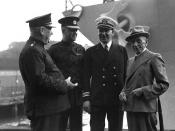Inspiration and Creativity The subject of creativity draws blank stares from many people, and for good reason. To the creative person, the world is an oyster, a never-ending source of wonderfully inspirational things to sing and write and dream about. Yet to the uncreative person, creativity is mysterious and fleeting like a Black Panther.
What is creativity though? Some people would say it's funny and joyful. Others would say it's sad and mournful. Still others would say it is both at the same time. One thing is common to all things creative though, seeing something that no one else sees. Creativity is being amazed, or "inspired"ÃÂ by things that are ordinary.
Where do people find inspiration is another important question. Perhaps people think inspiration comes from a "genie in a lamp"ÃÂ or some sort of inspirational supercomputer. Of course the real source of inspiration is much simpler. Inspiration comes from a variety of sources, such as experience, environmental triggers and internal ideas.
Inspiration comes from a variety of sources such as experience, environmental triggers and internal ideas, but what does that mean? In terms of environment, what kind of environment would be most beneficial for writing? Is a person more inspired in a busy park in the middle of downtown New York? Each person is different. What may be a perfect environment for one person may be terrible for different person, or what may be a great environment for a person one time, may be an unacceptable environment for the same person another time. In the short story "Works of the Imagination"ÃÂ by Gina Berriault the main character, Thomas Lang, is trying to write his memoirs by travelling the Swiss Alp countryside, but nothing around is inspiring him. "Through the translucent curtains the sky and the white mountains gave him enough light to write by but his hand was given nor reason to write. Was this another place he would leave, his notebook empty?"ÃÂ As the story continues, the environment around him begins to trigger old memories and emotions of which to write about. "Farther along, he stopped before a photograph of Der Eiger, the mountain looming up and over this hotel and over the town, miles below, a sheer, vertical face of stone. White lines were painted on the photograph, marking the ascents to the top, and at the base were the names of the fallen, preceded by white crosses. He passed along before the faces of the triumphant ones, a row of them, all young, and spent a longer time before a couple form Germany, a man and a woman, she a strongly smiling blond and he a curly haired handsome fellow, the kind who would take a woman along."ÃÂ At the end of the story he witnessing two people falling down the mountain to their deaths, and goes to the hotel manager to confirm his observation.
"'The couple on Eiger, they fell?' The manager's brow, high, smooth for a man his age, underwent a brief overcast. "ÃÂMay I ask who?' "ÃÂThe couple on Eiger.' "ÃÂAh yes, the photographs in the corridor? Only those who succeeded. Only those."ÃÂ "ÃÂThe couple up there now,' he said.
"ÃÂThere is no one climbing now.' "ÃÂThen they fell?' "ÃÂNo one is climbing and no one is falling.' Lang went up the stairs, hand on the rail, a weakness in his legs from the terror of the lives lost, no matter if they were specks, motes, undulations of the atmosphere. Up in his room he sat down at the desk, opened his notebook, and wrote the first word on the first of the faint lines that he likened now to infinitely fine, blue veins."ÃÂ After having a flashback of his friends falling off the mountain, triggered by the environment, Thomas was inspired to start writing his memoirs.
Another source of inspiration besides environmental triggers and internal thoughts are experiences. Experiences are the conscious events that make up a person's life. Experiences come in all shapes and sizes. They could be something as little as petting a kitten, or as life changing as jumping from a burning building. The biggest reason experiences are a good source of inspiration is that they enable a person to gain a deeper understanding of an event or emotion. In the poem by John Moffit, "To Look at Anything"ÃÂ Moffit encourages the use of experience and for inspiration. He explains that there is a definite difference between observation and experience.
"To look at this green and say "ÃÂI have seen spring in these Woods,' will not do"æ"àA further important part of experience is that they give a person a greater appreciation for things. The complexities of a situation or emotion cannot be completely assured unless a person experiences them for themselves. "Be the dark snakes of Stems and ferny plumes of leaves,"àMoffit also mentions that a person cannot merely half experience things, they must "get into it"àas much as they can. The person must not speed through the experience and attempt to absorb as much of it as they can. "You must enter in To the small silences between The leaves, You must take you time And touch the very peace They issue from."àExperience comes by looking, feeling, touching and being emotionally attached to a situation, and is a very important source of inspiration.
Inspiration can come from experience, and it can come from environmental triggers, but perhaps the most important inspiration comes from within. Sometimes people have no experiences on which they can draw anymore, and environmental triggers are just not working. That is when the truly gifted creative writer comes in, and is able to be inspired by his/her own internal thoughts. In the poem, "The Thought Fox"ÃÂ by Ted Hughes, there is nothing external to inspire him. So instead, Hughes must rely on his own internal thoughts for inspiration. He begins by imagining a blank page and a lack of idea.
"I imagine this moment's forest: Something else is alive Besides the clock's loneliness And this blank page where my fingers move."ÃÂ In this passage Hughes hints that an idea is coming, "Something else is alive,"ÃÂ but he does not know what it is yet. As the poem progresses, Hughes uses a fox as a metaphor for the inspiration he has that is coming into being.
"Cold, delicately as the dark snow, A fox's nose touches a twig, leaf; Two eyes serve as movement, that now And again now, and now, and now"ÃÂ The "fox"ÃÂ or inspiration is starting to emerge from the darkness of unknown, and come into the poet's head. His inspiration begins to appear clearer and clearer with each passing moment.
"Across clearings, an eye, A widening deepening greenness, Brilliantly, concentratedly, Coming about its own business"ÃÂ Hughes can now almost comprehend the entire inspiration, the fox is almost out in the open, where it can be seen. The inspiration is now almost perfectly indisputable to him.
"Till, with a sudden sharp hot stink of fox It enters the dark hole of the head.
The window is starless still; the clock ticks, The page is printed."ÃÂ Hughes' internal inspiration is now completely understood to him. It has filled his head and now he has printed it on paper. Notice how Hughes mentions that nothing external to him ever changed. "The window is starless still; the clock ticks."ÃÂ This unequivocally displays that it was not Hughes external environment that inspired Hughes. Nor was it an experience in which a he saw a fox in the darkness. Hughes wrote this poem from an internal inspiration.
Creativity is the ability to look at something ordinary, and express the feelings you get from it, extraordinarily. Creativity however, is nothing without inspiration. Inspiration is to creativity as marshmallows are to hot chocolate. Sure, the hot chocolate is good, but with a marshmallow the hot chocolate is transformed into a creamy smooth delicacy. Inspiration may come from a variety of sources, such as experience, environmental triggers and internal ideas.





